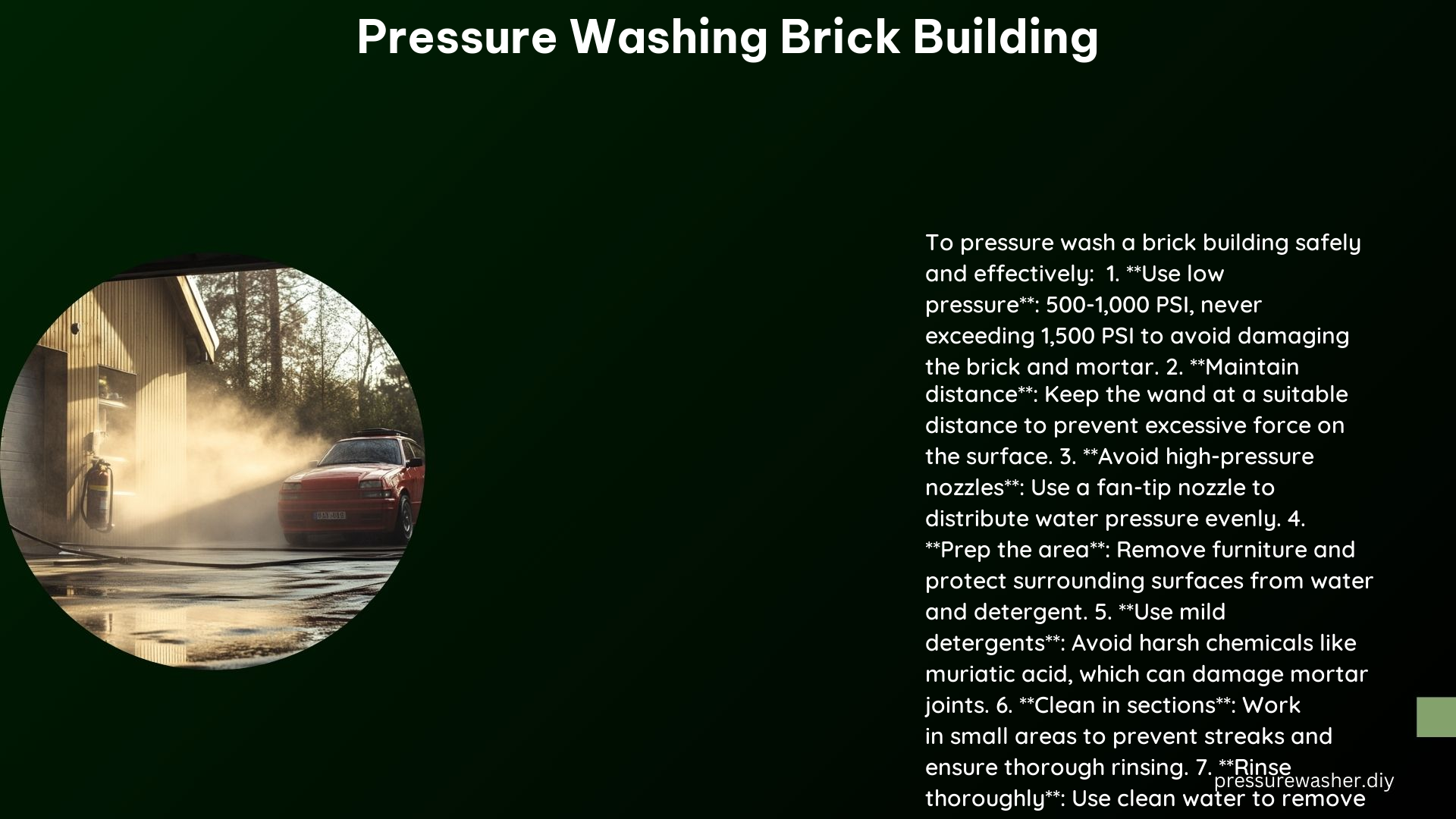Pressure washing brick buildings can be an effective method for cleaning, but it requires caution and the right techniques to avoid damaging the brick or mortar. This comprehensive guide will provide you with the necessary information to safely and effectively pressure wash your brick building, ensuring a flawless finish without compromising the structural integrity of the masonry.
Is It Safe to Pressure Wash Brick Buildings?
Yes, pressure washing brick buildings is generally safe if done correctly. Brick is a durable material that can withstand pressure washing, but it is not immune to high-pressure levels. Older brick homes or those with damaged mortar may require extra care or alternative cleaning methods.
The key to safe pressure washing of brick buildings lies in understanding the appropriate pressure levels and maintaining a suitable distance between the wand and the surface. Improper technique or excessive pressure can lead to cracking, chipping, or even the dislodging of bricks, making it crucial to follow the recommended guidelines.
Recommended Pressure Levels

- Low pressure: 500-1,000 pounds per square inch (PSI) is the recommended pressure range for cleaning masonry. This low-pressure setting ensures that the water flow is gentle enough to remove dirt, grime, and other surface contaminants without causing any damage to the brick or mortar.
- Distance: Maintain a distance of at least 6 inches between the pressure washer wand and the brick surface. This distance helps to distribute the water pressure evenly across the surface, preventing any focused areas of high pressure that could potentially cause harm.
- Never exceed 1,500 PSI: Going beyond this pressure level can be detrimental to the structural integrity of the brick and mortar, leading to cracking, chipping, or even the dislodging of bricks.
Precautions and Tips
To ensure a successful and safe pressure washing experience, consider the following precautions and tips:
- Avoid high pressure: Start with the lowest pressure setting on your pressure washer and gradually increase the pressure if necessary. Constantly monitor the surface for any signs of damage and adjust the pressure accordingly.
- Use the right nozzle: A fan-shaped nozzle is the best choice for pressure washing brick surfaces. This type of nozzle helps to spread the water pressure evenly across the surface, reducing the risk of focused high-pressure areas.
- Avoid harsh chemicals: Steer clear of muriatic acid or other aggressive cleaning solutions, as they can break down the mortar joints and cause significant damage to the brick.
- Clean in sections: Divide the area you’re cleaning into smaller, manageable sections. This approach allows you to focus on each section thoroughly, ensuring a consistent and thorough cleaning process.
- Rinse thoroughly: Use large amounts of water to rinse the surface, especially after using any cleaning solutions. Proper rinsing helps to remove any residual chemicals or debris, preventing potential damage to the brick or mortar.
Special Considerations for Old Brick Buildings
When dealing with older brick buildings, additional precautions and techniques may be necessary to ensure a successful and safe pressure washing process:
- Check the mortar: Carefully inspect the condition of the mortar joints before starting the pressure washing process. If the mortar is fragile or deteriorating, it may be more susceptible to damage from high-pressure water.
- Avoid power washing: If the mortar is in poor condition, it’s best to avoid power washing altogether. Instead, consider alternative cleaning methods, such as the “wet and forget it” technique or sandblasting with walnut shells, which are gentler on the masonry.
Technical Specifications
To achieve the best results while pressure washing brick buildings, adhere to the following technical specifications:
- Pressure washer settings: Use a low-pressure setting between 500-1,000 PSI and a wide fan-shaped nozzle to distribute the water pressure evenly.
- Cleaning products: Opt for mild detergents like Palmolive or Dawn, and avoid commercial detergents and solutions that may contain harsh chemicals.
- Water temperature: Use lukewarm or cool water, as hot water can potentially cause thermal shock and damage the brick or mortar.
- Cleaning pattern: Work in a consistent, overlapping pattern, ensuring that you cover the entire surface thoroughly.
- Dwell time: Allow any cleaning solutions to dwell on the surface for the recommended duration before rinsing, as specified by the product manufacturer.
Additional Resources
For further information and guidance on pressure washing brick buildings, consider the following resources:
- Washh: “Can You Pressure Wash A Brick House? How To Do It?” – A detailed guide on pressure washing brick houses, including tips and precautions.
- BrickImaging: “How to Pressure Wash a Brick House” – A comprehensive guide on pressure washing brick surfaces, including recommended pressure levels and cleaning techniques.
- Briggs and Stratton: “How to Clean Brick and Mortar with a Pressure Washer” – A video guide on cleaning brick and mortar using a pressure washer.
- Reddit: “Ok to power wash old brick? Anything I should keep in mind?” – A discussion on the safety and considerations of power washing old brick buildings.
- Pressure Washers Direct: “How to Clean Brick and Mortar Walls” – A guide on cleaning brick and mortar walls using pressure washers, including tips on wetting and rinsing the surface.
By following the guidelines and recommendations outlined in this comprehensive guide, you can safely and effectively pressure wash your brick building, restoring its appearance and preserving the structural integrity of the masonry.
Reference:
1. Washh – Can You Pressure Wash A Brick House? How To Do It?
2. BrickImaging – How to Pressure Wash a Brick House
3. Briggs and Stratton – How to Clean Brick and Mortar with a Pressure Washer
4. Reddit – Ok to power wash old brick? Anything I should keep in mind?
5. Pressure Washers Direct – How to Clean Brick and Mortar Walls
